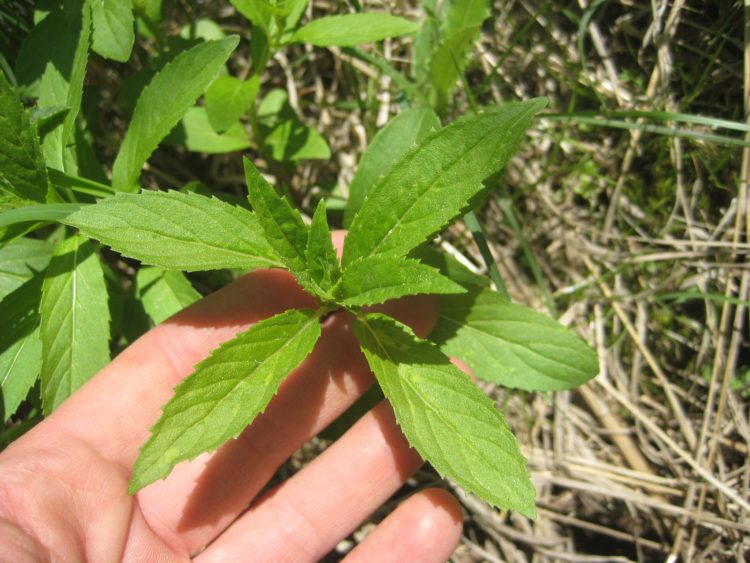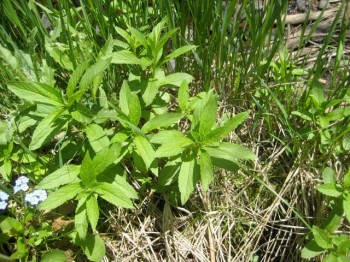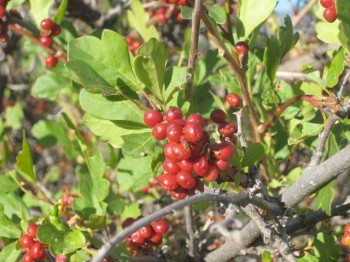
There’s nothing like accompanying your boyfriend to a work meeting expecting to sit idly by and instead being invited to forage the back yard.
“I’ll weed your garden while I wait,” I offered to his new web client, glancing hungrily at the carpet of young goosefoot (Chenopodium sp.) decorating the landscape.
“Oh, you don’t need to weed it,” he told me, “but feel free to graze as much as you like.”
We apparently got there just in time too because the landlord would be coming by shortly to spray the weeds. I found a plentiful and diverse trove of edibles there in Kittredge, Colorado, including several that I have not yet had the opportunity to collect. Among them was an inconspicuous wild mint mixed in among the other weeds on the bank of the creek that abuts the property.
“If it has a square stem and smells like mint, it’s an edible mint,” Cattail Bob Seebeck told me on a recent foraging adventure. Not all squared-stemmed mints smell or taste like mint—for example, wild oregano (Monarda fistulosa) and horehound (Marrubium vulgare)—but there are a few wild ones that evoke the commercial variety, making them as palatable to the masses as they are to obsessive wild food foragers like yours truly.

The mint I collected is field mint (Mentha canadensis or M. arvensis), a native species found across the northern and western United States. It loves moist soils, and can often be found along streams and cattail marshes. It can occur in small patches or extensive populations.
Often, the best way to find it is by your nose. This is a very flavorful mint, whose aroma arrests me instantly should I be so fortunate as to stumble through a patch. It is my hands-down favorite.

Wild Mojitos Made Wrong Are Marvelous Nonetheless
Back in Fairplay, I sent Gregg to the store for rum, club soda, limes and instructions on how to make mojitos. He came home with 7-Up telling me we didn’t need any limes. Later I mixed two tall glasses of crushed mint with ice, 7-Up, and rum. Although our ingredients produced a sub-par mojito, I still melted into my chair upon tasting it. I love wild mint and I love mojitos. My favorite part is chewing up the minty leaves after the drink is gone.
Good as they were, however, I did root through the fridge about halfway through and found a lime to squeeze into our drinks. “Oh! That’s good!” Gregg exclaimed before pulling up a recipe that called for club soda, ½ lime, mint, 2 tsp of sugar, and rum to make the genuine Cuban mojito that Ernest Hemingway enjoyed.
Minty Skunkbush Sauce
Two quasi-mojitos later, I served up the next wild mint experiment—a minty, sweet and sour three-leaved sumac sauce served with batter-fried fish. “This is amazing,” Gregg opined emphatically, helping himself to more, though I’m not sure how much of that was the rum talking.

Three-leaved sumac or skunkbush (Rhus trilobata, R. aromatica) is related to the other edible sumacs like R. typhina and R. glabra that bear their fruits in cone-shaped upright clusters, but the fuzzy, red-orange fruits are borne in smaller clusters spread throughout the bush. Unlike the relatives, the leaflets occur in groups of three, each broad at the tips with rounded lobes, tapering at the base. All have a strong, lemony flavor, hence the common use to make a lemonade-like drink.
A few words of caution: Kershaw et. al. (1998) warns that “people who are hyper-sensitive to poisonous members of this genus (e.g., poison-ivy) may also be allergic to this ‘safe’ sumac.” And in The Forager’s Harvest (2006), Sam Thayer notes that people who are allergic to cashews and mangoes should avoid the sumacs or proceed with caution, since they are related species.
I made the tart, minty sauce by simmering a handful of berries in water to release their lemony flavor, then adding sugar and finely chopped mint and letting it steep. Later, I read in Steve Brill’s book (1994 ) that hot water “destroys vitamin C and washes undesirable quantities of tannin into your drink,” so he recommends swishing the berries or berry clusters in cold water for a couple of minutes instead.
Nevertheless, it made for a very good sauce that I will definitely make again, although I might take a page out of Brill’s book and see if I can release the tart essence into cold water the next time around.

Creamy Wild After-Dinner Mints
Mint is good for digestion, hence the popularity of the after-dinner mint. And, while Gregg can attest to the fact that I am no confectioner (my horehound candies either failed to reach or overshot the hard crack stage and instead sat drying into “bark” on a cookie sheet for several months), I decided to attempt mint candy creams with the remainder of our foraged bounty.
Proportions be damned, I mixed up a few ounces of cream cheese, a tablespoon of butter, and several cups of confectioners’ sugar. Standard recipes call for peppermint extract, so after a failed attempt at creating an extract by simmering mint in a small amount of water (which ended up tasting nothing like mint), I surrendered to the strong aroma of fresh mint in the kitchen and stuffed a batch of the raw stuff into the food processor before adding it straight to the candy mixture. Then I rolled it into small balls with plenty of confectioners’ sugar to keep them from being too sticky to handle, pressed flat with a fork dipped in more sugar, and let them dry for a couple hours, storing them afterwards in the refrigerator because of the raw mint.
Upon tasting, Gregg emitted two big “wows” one after the other as he was hit first by the unexpected creamy texture and second by the strong “minty blast” of these flavorful mints. Honestly these were fantastic and I polished them off very quickly.
Who says I can’t be a wild confectioner?
Updated 2.26.21

What a great idea! I can remember making wedding mints for all of my aunts weddings as a kid, and they were quite similar – cream cheese, butter, powdered sugar, and mint extract – all pressed into cute little molds. I’m guessing someone is going to want to dip these in chocolate.
OMG you hit the nail on the head, B. I want to dip these in chocolate! But how?
Freeze them first, then dip in chocolate. Or, if you don’t mind that they’re not totally covered, just drizzle refrigerated ones with choc. 🙂
I love that you foraged wild mint! To make your mojitos even more authentically cuban, be sure to use cane sugar. We’re enjoying mojitos from the curly mint that showed up in our vineyard. Talk about refreshing!